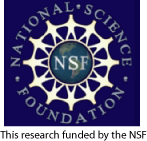
Potassium Metasomatism

The potassium (K) content of average surface crustal rocks across the US varies widely, and there are areas of the western US where K is extremely high, regardless of the local rock type. These areas tend to be in areas of relatively arid climates, and many occur in areas of basin-and-range extension, such as the area of our study, around Socorro, NM. At least some of these areas of K enrichment are caused by a process of K-metasomatism, in which the element K has been enriched in existing rocks by a secondary fluid process. One possible mechanism for enrichment of K and other elements is alteration of local rocks by low temperature alteration by alkaline, saline brines.
The object of this research is to try to understand element mobility and the processes which control elemental enrichments and depletions in the Socorro K anomaly. The area of relatively strong metasomatism is about 1000 km2 in extent, and rocks in the most strongly metasomatized areas contain up to 13 wt.% K2O. This area of metasomatism has been interpreted by Chapin and Lindley and others to be the results of the presence of alkaline-saline brines a hydrographically-closed basin. Extension-related subsidence in this area during a time of dry climate would allow this alkaline-saline brine basin to evolve, and perhaps remain active over a long period of time.
The Socorro area is well-suited to study because of its large areal extent, as well as the presence of a number of silicic ignimbrites and mafic lavas that can be sampled in both metasomatized and unmetasomatized areas. The characteristic alteration mineralogy in highly metasomatized rock is adularia + hematite ± quartz ± clay whereas in rocks which may not be strongly metasomatized the assemblage is dominated by clays and zeolites. Typically, low-K crystals, such as plagioclase, are preferentially attacked by the K-bearing fluids. Dating by 40Ar/39Ar suggests that the alteration occurred between 8 and 10 Ma. Elements such as K, As, Rb, Sb, Ag, Cs, Au, Pb, Th, and U are enriched in the altered rocks, whereas Na, Mg, Ca, and Sr are depleted. Some trace elements, rather than varying smoothly with degree of rock alterations (estimated by K/Na ratio), change dramatically during either low or high degrees of alteration. These data suggest that the trace element signature of alteration may be dependent on the mineralogical alteration assemblage, which may, in turn, be dependent on the composition of fluids which cause alteration.
- BERATAN, K. K., B. PEER, N. W. DUNBAR, and R. BLOM, 1997, A remote sensing approach to alteration mapping: AVIRIS data and extension-related potassium metasomatism: International Journal of Remote Sensing, v. 18, 3595-3609. ABSTRACT
- DUNBAR, N.W., CHAPIN, C.E., ENNIS, D.J., and CAMPBELL, A.R., 1994. Trace element and mineralogical alteration associated with moderate and advanced degrees of K-metasomatism in a rift basin at Socorro, New Mexico. N. M. Geol. Soc. Guidebook, 45, 225-232. ABSTRACT
- DUNBAR, N.W., CHAPIN, C.E., and CAMPBELL, A.R., 1994. Trace element and mineralogical alteration associated with moderate and advanced degrees of K-metasomatism in a rift basin at Socorro, NM. SME Technical Program, Feb 14-17, 48. ABSTRACT.
- DUNBAR, N. W., S. KELLEY, and D. MIGGINS, 1996, Chronology and thermal history of potassium metasomatism in the Socorro, NM, area: Evidence from 40Ar/39Ar dating and fission track analysis: New Mexico Geology, v. 18, p. 50. ABSTRACT
- ENNIS, D.J., DUNBAR, N.W., CAMPBELL, A.R., and CHAPIN, C.E., 1994. Potassium Metasomatism of silicic ignimbrites: The relationship between the mineralogical assemblage and the chemical changes associated with potassic alteration. New Mexico Geology, V. 16, p. 35. ABSTRACT
- ENNIS, D. J., N. W. DUNBAR, A. R. CAMPBELL, and C. E. CHAPIN, (in press), The effects of K-metasomatism on the mineralogy and geochemistry of silicic ignimbrites near Socorro, New Mexico: Chemical Geology. ABSTRACT
- MAILLOUX, B., M. PERSON, P. HUDLESTON, N. DUNBAR, S. KELLY, and S. CATHER, 1996, Tectonic controls on the hydrothermal evolution of the La Jencia and Socorro Basins of the Rio Grande Rift: Implications for potassium metasomatism: EOS, Transactions of the American Geophysical Union, v. 77, p. S105.
- MAILLOUX, B., M. PERSON, P. HUDLESTON, N. DUNBAR, S. KELLY, and S. CATHER, 1996, Tectonic controls on the hydrothermal evolution of the LaJencia and Socorro Basins of the Rio Grande Rift: Geological Society of America Abstracts with Program, v. 28, p. A-255.
- MAILLOUX, B., M. PERSON, S. KELLY, N. DUNBAR, L. STRAYER, S. CATHER, and P. HUDLESTON, 1999, Tectonic controls on the present-day and paleohydrology of the Rio Grande Rift, New Mexico: Water Resources Research, 35, 2641-2659. ABSTRACT.
- PERSON, M., B. MAILLOUX, L. STRAYER, P. HUDLESTON, S. CATHER, and N. W. DUNBAR, 1995, Tracing groundwater flow across sedimentary basins using geothermal data: A Bredehoeft legacy: Geological Society of America Abstracts with Program, v. 27, p. A-312.
Return to HOMEPAGE

